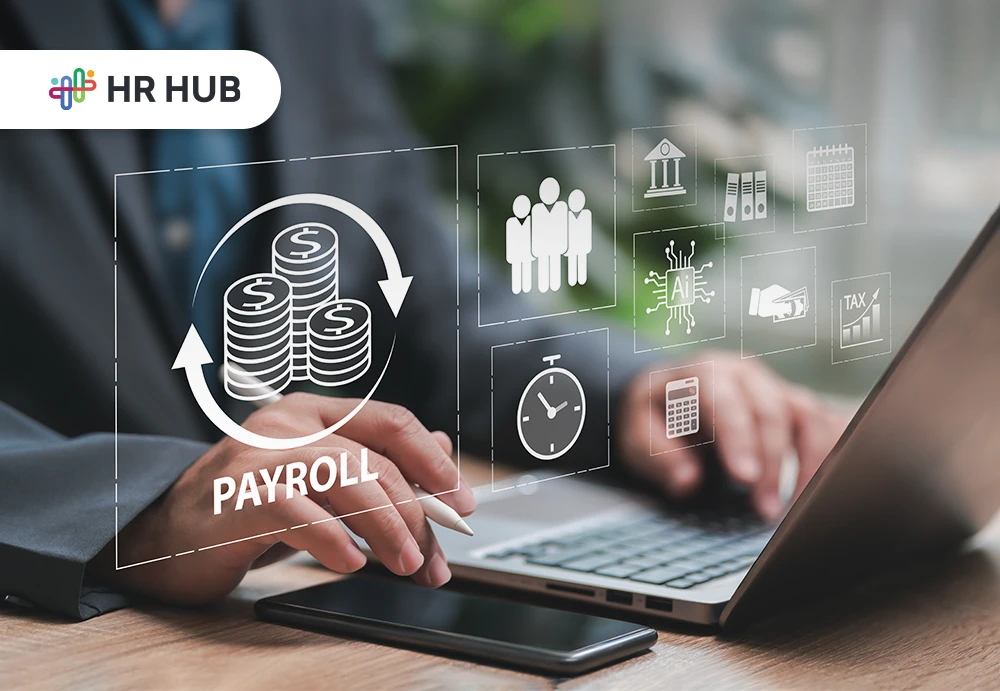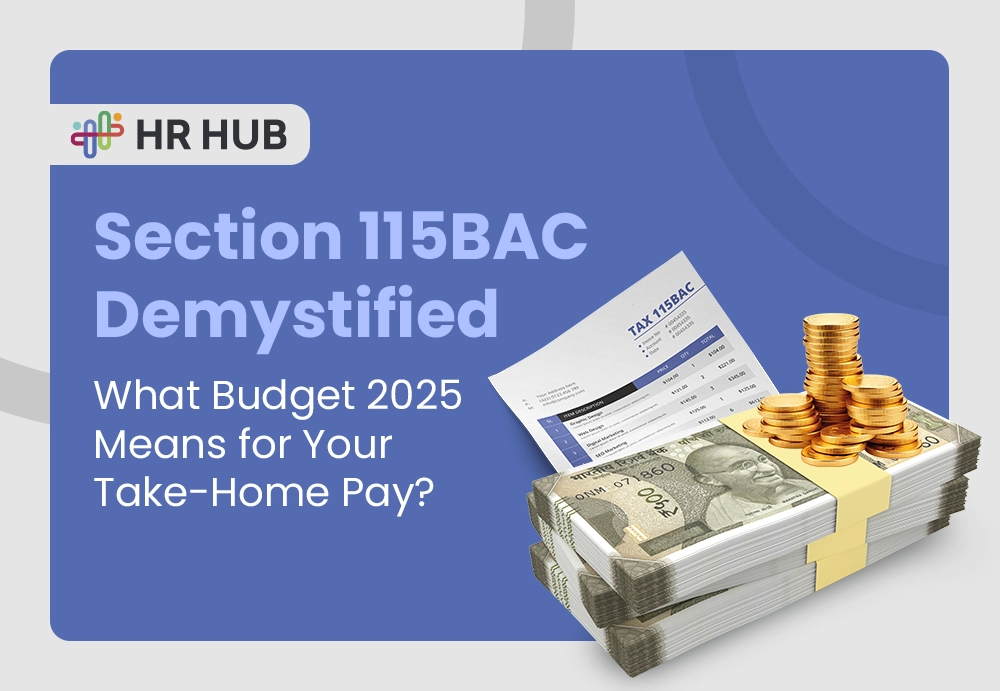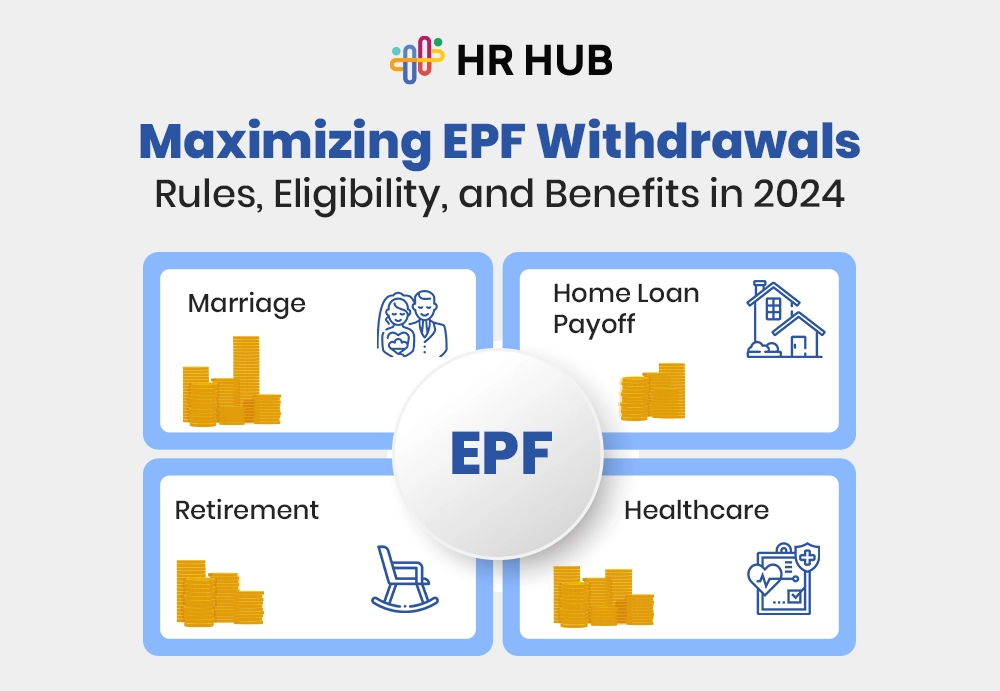


This site uses cookies to deliver our services. By using our site, you acknowledge that you have read and understand our Cookie Policy. Your use of HR HUB's services is subject to these policies.

Imagine that your finance team is letting out a collective sigh of relief on payday, not because they're finally done with manual tax adjustments and late-night calculations, but rather because everything went off without a hitch. Payroll automation is revolutionary for businesses that prioritize efficiency, accuracy, and a happier workplace.
However, what exactly is automatic payroll? Consider it the key to effective salary processing, where you can concentrate on expanding your company while advanced algorithms manage intricate computations, tax deductions, and compliance checks.
Let's examine why putting in place automatic payroll systems is a deliberate choice rather than just a modern convenience.
Although it may have been commonplace ten years ago, manual payroll is now an ineffective holdover. Processing employee payments manually requires a considerable amount of time to verify data, recalculate taxes, and prepare reports. Every time an employee joins, leaves, or changes roles, adjustments need to be made—often with tight deadlines.
With automatic payroll systems, these hours are reclaimed. The system automatically calculates earnings, deductions, bonuses, and taxes based on preset rules and real-time data from attendance and leave records. Imagine reducing payroll processing time by 50-80% and giving your HR team the bandwidth to focus on talent management, employee engagement, and compliance strategies.
Real-World Example: By reducing the payroll cycle from four days to less than one and implementing automatic payroll, a mid-sized company freed up HR resources to concentrate on employee satisfaction programs.
Payroll isn’t just about crunching numbers—it’s a delicate balancing act of precision and regulation. From incorrect tax deductions to significant compliance penalties, even a small error can have major consequences. Imagine not having to worry about an incorrect TDS deduction or a missed compliance deadline because your payroll system will now take care of everything automatically, silently, and in the background.
That’s the promise of automatic payroll systems. These aren’t just digital calculators—they’re meticulous compliance guardians. They automatically apply complex tax rules, accommodate region-specific regulations, and adjust for policy updates—all without a single human keystroke.
Why Does This Matter?Let’s say your business operates in multiple Indian states. Each has unique labor laws, tax exemptions, and minimum wage standards. A manual system struggles to keep pace with these complexities, increasing the risk of compliance gaps.
But an automatic payroll system is programmed to recognize regional variations, ensuring every employee’s payroll complies with local laws and national regulations, whether it's EPF, ESIC, or state-specific professional tax.
Going Global? No problem.
Imagine expanding your business internationally—say, adding a team in the U.S. where state and federal tax codes overlap.
An automatic payroll system that supports multi-country compliance can handle the maze of federal, state, and even city taxes, automatically calculating deductions, benefits, and withholdings. This not only saves time but also protects your business from legal risks and reputational damage.

This is because these systems ensure continuous compliance by being updated regularly to reflect the latest tax and legal developments.
No More Frantic UpdatesTake into account those last-minute changes to government regulations, like an abrupt shift in the EPFO contribution rates or new guidelines for digital taxes. Errors and delays may result from HR teams' inability to comprehend and apply changes when payroll is done manually.
Automatic payroll systems handle these updates instantly, reflecting changes without disrupting ongoing payroll cycles.
Real-Life Glimpse:
Due to a human error in calculating overtime for weekend shifts, a large manufacturing company once faced a crippling compliance fine for breaking labor laws.
After switching to an automatic payroll system, such errors vanished. To meet legal and employee requirements, the system generates comprehensive compliance reports, integrates with attendance logs, and automatically applies the correct overtime rates.
Always ready for an auditIn a world where financial transparency is paramount, automatic payroll provides detailed audit trails—recording every change, approval, and payout. Need a report for the last financial year? In just a few minutes, the system produces it, ready for external compliance checks or internal audits.
Payroll errors are more than just a hassle for workers, let's face it. It’s a breach of trust. Consider getting a paycheck that is even a few days late, omits a day's wages, or contains inaccurate deductions. For employees, that’s more than just a financial hiccup—it’s a question of how much the company values them.
Switch to automatic payroll, and suddenly, your payday becomes predictable, transparent, and stress-free. Each employee receives an accurate paycheck on time, every time, without needing to send frantic emails to HR or the finance department. No more “Hey, my tax deduction looks wrong” or “Why is my bonus missing?”—because the system has already cross-checked everything for accuracy.
Global Flexibility: If you have teams working remotely across different time zones or geographies, automatic payroll systems can handle local tax rules and payment timelines. It doesn’t matter if your employee is in Mumbai, Chicago, or Singapore—they’ll be paid the right amount at the right time.
Pro Tip: Many modern automatic payroll systems offer self-service portals where employees can log in at any time to view their payslips, check tax deductions, submit reimbursement claims, and download compliance certificates, such as Form 16 or W-2.
Team members can focus on high-value tasks by lowering the frequency of routine HR inquiries and encouraging a sense of empowerment.
Case Study: A services company installed an automated payroll system and self-service portal. Employee inquiries to HR decreased by 40% in just three months, and overall satisfaction scores significantly rose. Employees appreciated the convenience and transparency of having access to their payroll data whenever needed.
When you’re running a growing business, your workforce doesn’t just stay constant—it expands, diversifies, and becomes more complex. A startup with 20 employees might manage with spreadsheets, but when you’re scaling up to 200 or 2,000 employees, that approach simply won’t cut it.
That’s where automatic payroll systems shine. They scale with your business needs, handling everything from hourly employees and contractors to salaried staff, all with different pay structures, benefits, and compliance requirements.
Built for Complexity: Whether it’s different pay periods (weekly, bi-weekly, monthly), customized bonus structures, or variable shift differentials, automatic payroll adapts. You can easily add new locations, integrate with time-tracking systems, and manage diverse tax jurisdictions—all without adding new HR staff or reinventing your payroll process.
Real-World Story: Within a year, a rapidly growing e-commerce company expanded from 50 to 500 employees in three countries. They were able to ensure compliance, modify payroll structures, and onboard new hires without increasing HR's workload by implementing automatic payroll. Their rapid expansion was accommodated by the system's scalability, ensuring that payroll went smoothly every month.
Payroll is the lifeblood of HR operations and is more than just a set of numbers. Payroll incorporates performance bonuses, leave approvals, attendance records, and expense reimbursements. Switching between systems is a common part of manual processes, which can result in mistakes, duplicate entries, and delays.
Presenting contemporary automated payroll systems that seamlessly integrate with your HR technology stack. From attendance management tools to benefits platforms, everything connects in real-time. When an employee’s leave is approved, it’s automatically reflected in payroll. When performance bonuses are finalized, they’re added to the next paycheck, without manual input.
Integration in Action: One HR HUB client integrated payroll with attendance, leave, and performance systems. The system seamlessly updated compliance reports, computed the correct payout, and automatically applied overtime rates when an employee clocked in for an unscheduled weekend shift. This avoided possible compliance gaps and saved HR teams hours of reconciliation.
Beyond HR: Payroll data is synchronized with general ledgers and tax filings through integration with accounting and finance tools. As a result, a cohesive ecosystem is created in which data flows easily, decisions are made more quickly, and compliance is a feature that is inherent rather than an afterthought.
Let's talk about the bottom line now. Payroll processed manually is not only costly but also time-consuming. The time needed to complete calculations, approvals, and reconciliations can add up quickly. Your profitability may be severely impacted when you account for the cost of errors like incorrect tax deductions, late payments, or compliance penalties.
The cost savings from switching to automatic payroll are substantial. In addition to saving processing time, it also minimizes errors and the need for costly corrections. Additionally, real-time reporting and predictive analytics provide insight into payroll costs, aiding in more effective budget planning.
Companies that automate payroll save an average of $1,200 per employee per year, per a PwC report. That is a strong argument for switching, not just a statistic.
Added Value: Automatic systems can also assist in locating areas where money can be saved, such as by maximizing overtime, improving benefit administration, or redirecting resources to ventures that generate income.
Payroll data is a wealth of information that goes beyond simply listing who was paid. Automatic payroll systems give companies access to real-time dashboards that highlight salary trends, tax liabilities, benefit costs, and compliance metrics.
Strategic Edge: Consider applying payroll analytics to predict turnover patterns, determine which departments have the highest labor costs, or assess how incentive programs affect output. By doing this, payroll is transformed from a back-office task into a strategic decision-making tool.
Practical Takeaways: HR directors can utilize these data points to create more effective workforce strategies, bargain for better benefit plans, or pinpoint training requirements—all based on actual statistics.
Example: Payroll analytics were used by an HR HUB client to pinpoint a department's increased overtime expenses. By investigating further, they discovered workflow inefficiencies and implemented process changes that cut overtime by 30% within a quarter.
In the era of hybrid work and digital nomads, payroll must transcend geographical boundaries. Traditional systems often falter when faced with remote employees working in different states or countries, each with its own tax regulations and labor laws. This is where automatic payroll systems shine—they’re designed to handle the intricacies of multi-location payroll effortlessly.
Imagine This: An employee logs work hours from home in Bangalore, while another clocks in from a co-working space in Dubai. With manual payroll, this would be a logistical nightmare, involving multiple spreadsheets and constant cross-checking of regional tax codes.
Automatic payroll systems consolidate this information, apply local tax rules, and process payments accurately, ensuring that every remote worker is compensated correctly and in compliance with relevant regulations.
Added Value: These systems often feature IP-based tracking and geolocation capabilities, which automatically apply the appropriate tax deductions and benefits based on the employee's location. Plus, they can accommodate flexible work schedules and varied time zones, making payroll truly borderless.
Payroll data is a goldmine of sensitive information—salaries, tax IDs, bank details, and social security numbers. Manual processes increase the risk of data breaches, misplaced files, and unauthorized access. Automatic payroll systems prioritize security by employing robust encryption protocols, secure cloud storage, and role-based access controls.
For example, in a manual setup, a misplaced USB drive containing payroll data could expose hundreds of employees to identity theft. However, with a secure automatic payroll system, data is encrypted both at rest and in transit, and is accessible only to authorized users. Multi-factor authentication and audit logs further enhance security, ensuring every access or change is recorded and traceable.

Investing in a secure payroll system isn’t just smart—it’s essential.
Manual payroll procedures are susceptible to interruptions from natural disasters, hardware malfunctions, and power outages. Files can be lost, payments can be delayed, and compliance deadlines can be missed. Automatic payroll systems, especially cloud-based solutions, offer built-in disaster recovery mechanisms.
Picture This: A sudden flood damages your office, making local servers and physical files inaccessible. With a cloud-based automatic payroll system, all data remains secure and accessible from anywhere, allowing payroll to run as usual. This protects your company's reputation and the livelihoods of your employees by guaranteeing business continuity.
Real-World Perspective: Many companies with manual payroll systems struggled to process salaries remotely during the COVID-19 pandemic. However, payroll operations continued to run smoothly for those with automated systems, even as teams switched to working remotely overnight.
Every organization has different payroll requirements. Multi-level approval workflows may be necessary for some, while special provisions for overtime, commissions, or bonuses may be required for others. Systems for automatic payroll offer a wide range of customization options to suit your specific business needs.
For instance, a business may establish a procedure in which bonuses require approval from both the department head and HR, but expense reimbursements are routed through the finance team. With automation, these workflows are configured once and run seamlessly, eliminating manual handoffs and bottlenecks.
Why It Matters: Customizable workflows ensure compliance with internal policies, reduce errors, and maintain a clear audit trail. This is especially crucial for companies with complex hierarchies or varying approval levels.
One of the most overlooked aspects of payroll is communication. Manual systems often leave employees in the dark about payment status, tax updates, or benefits changes. Automatic payroll systems transform this by offering self-service portals, instant notifications, and real-time updates.
Employee Empowerment: Employees can log in to view their payslips, tax summaries, bonus allocations, and leave balances—all in real time. They can also update personal information, submit reimbursement claims, and track approval statuses without waiting for HR.
Why It Matters: This transparency builds trust, reduces anxiety around payroll, and creates a sense of inclusion. When employees feel informed and valued, engagement and retention improve naturally.
Candidates assess possible employers in today's competitive job market based on their treatment of employees as well as their pay. Payroll procedures that are dependable, accurate, and transparent show that a business values its employees and maintains order in its operations.
For example, businesses that process payroll automatically and on time are more likely to attract top talent than those that have a poor reputation for processing payments incorrectly or late.
During interviews, you can set yourself apart from competitors by showcasing your robust payroll system, which incorporates employee self-service, open communication, and automated compliance.
Why It Matters: A strong payroll system doesn’t just impact existing employees; it’s a powerful employer branding tool that attracts high-quality talent who value reliability and professionalism.
In today’s fast-paced business world, waiting for manual processes to catch up is like expecting a fax machine to outrun a high-speed internet connection. Automatic payroll systems are no longer optional—they’re essential for accuracy, compliance, scalability, and employee trust.
Here's where HR HUB is useful. In addition to processing salaries, our automated payroll module manages tax deductions, employee benefits, and other payroll-related duties. To deliver error-free payrolls and adapt to changing regulations, it seamlessly integrates with attendance, leave, and compliance features. Regardless of your company's size, HR HUB turns payroll from a time-consuming chore into a competitive advantage.
Observing the Future: Are you prepared to bid manual payroll troubles farewell? It's time to adopt a system that puts in just as much effort as you do. Your business and employees will appreciate it.



Ready to streamline your HR processes? Contact us today to learn how HR HUB can help your organization thrive. Fill out the form, and one of our experts will reply shortly. Let's empower your workforce together!
